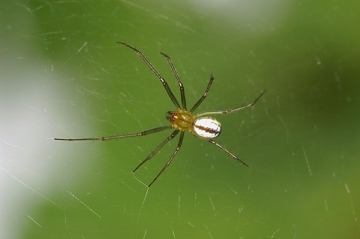Summary for Neriene emphana (Araneae)
previous species | next species
National Distribution
Terms of Use. Double-click on map to go to region

Explore Regional Distribution
Please log on and add a note on this species
About this species
Recorded altitude range60m to 60m
Species text
DistributionThe species was discovered in Britain in August 2000 on the Isle of Wight in Brighstone Forest, at over 500 ha the largest area of woodland on the island. N. emphana is widespread on the European continent as far north as Denmark and southern Finland, occurring east across temperate regions of Eurasia to China and Japan.
Habitat and ecology
N. emphana typically occurs on the lower branches of trees and bushes in dark woods, both coniferous and broad-leaved, sometimes associated with beech. The British specimen was beaten from a shaded holly tree at the edge of a rather dark and gloomy mature beech forest with scattered yew and some sycamores along a forest road. Linyphia triangularis was common on the same tree. The sheet web, which may be slightly domed, is built on the lower branches of trees, but well off the ground. It is mature in summer.
Status
A single female has been found. The spider is probably a relatively recent arrival, but does not seem to have followed the example of Small Red-eyed Damselfly Erythromma viridulum which had been spreading north on the European mainland and was unknown in Britain prior to its initial discovery in Essex in 1999 (Cham 2001), colonised the Isle of Wight, being discovered at several sites on the island in 2000 and is now found widely in southern England.
Threats
If it becomes established, the spider is unlikely to be threatened.
Management and conservation
No specific management is likely to be needed other than protection of the natural vegetation structure and topography.
Text based on Dawson, I.K., Harvey, P.R., Merrett, P. & Russell-Smith, A.R. (in prep.). References
Adult Season
Habitats
background methodology
Recorded management for locations with Neriene emphana
Recorded substrate and hydrology for locations with Neriene emphana
Images
please log on and upload a new image for this speciesSee also A-Z Species Index - A-Z Picture Index - previous species | next species
